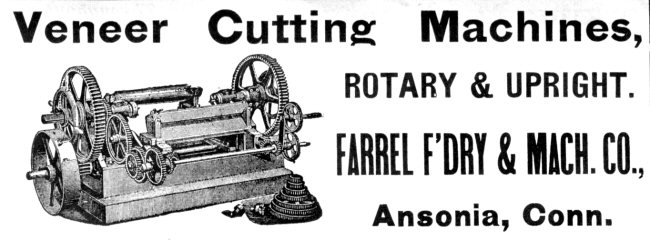 |
| From May 1889 The Wood-Worker |
This company was founded in 1848 by Almon Farrel, as Almon Farrel & Co.; it became the Farrel Foundry a couple of years later. In 1857, following Almon Farrel's death, it became the Farrel Foundry & Machine Co., under the leadership of Almon's son, Franklin Farrel, who would remain as president for some decades. An 1889 ad shows that company's veneer cutting machines. It is not known for how long they made woodworking machinery. We have also seen a roughly 1960 cutter grinder from Farrel Corp. The company went through a series of mergers and acquisitions, culminating in a 1989 absorption by Black & Decker Corp.
Information Sources
- Ad in the May 1889 issue of "The Wood-Worker", for their rotary and upright veneer cutting machines.
- The University of Connecticut Library's business collection includes files from this firm. Their web page entry for the company provides the following information.
Ansonia and Derby, Connecticut, foundry and manufacturer of heavy machinery. Founded in 1848 as Almon Farrel and Company in Ansonia, changing its name to Farrel Foundry in 1850. Reorganized in 1857 as the Farrel Foundry and Machine Company; merged with the Birmingham Iron Foundry (founded in 1836) in 1927 to form Farrel-Birmingham Company, Inc. Acquired Consolidated Machine Tool Corporation in 1951; changed its name again to Farrel Company in 1963. Became a division of United Shoe Machinery and was part of the merger of that company with Emhart Corporation in 1976. Emhart Corporation dissolved in 1989 when it merged with Black & Decker Corporation. Collection consists of administrative files, correspondence, sales and marketing records, general accounts, production records, labor records, newspaper clippings and publications, audio-visual records (including photographs, reel-to-reel tapes, plans and blueprints, and memorabilia), and historical papers.
- The American Cane Mill, ©2010, pg. 150